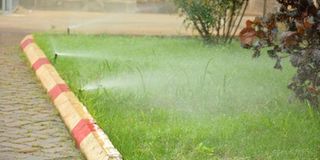Get your garden watered right

Sprinkler systems help conserve water. You can set them to water during the night to take advantage of the coolest possible temperatures. PHOTOS BY GODFREY LUGAAJU
What you need to know:
- The best time of day to water your garden is in the morning.
- If the morning is not possible then wait until after 4pm. If you do water in the evening, make sure that there is enough sun left for leafs to dry out before dark. Damp leaves can lead to problems with fungus.
The care given to your garden will guarantee how long you keep your plants alive and green. Unlike the horse irrigation system of manually watering your garden with waterlogged cans and kettles, there are some modern techniques that come in handy and save time.
Phanendra Geddam, the senior sales manager at Rain Bird Irrigation System takes us through the different techniques that can be employed in your garden.
Set up
“Depending on the size of one’s garden, we do a site survey before setting up the irrigation system. If one is using shrubs, we design drip irrigation in their garden spaces.
However, if a garden space has both shrubs and flowers, we set up the sprinkler system,” he explains. Geddam suggests micro sprinklers of three metre radius installed in corners at adjustable angles. These sprinkle water allover the garden, whereas drip-lines are buried into the ground for water to easily drop onto plant roots.
Available types
“The quality of irrigation systems is very important as it determines its durability. This is because the material is easily exposed to weather and soil,” cautions Geddam. For garden spaces, Geddam recommends sprinkler, drip, and micro-sprinkler irrigation systems among others depending on space and client’s choice.
Drip irrigation system
Julian Komugisha, an irrigation engineer at Rain Bird Irrigation, says drip line irrigation uses minimal water and only gives water to the root zone of the plant.
She further explains: “This method of irrigation is used for plants with definite spaces such as vegetables. We lay the pipes in the ground within a distance of 30, 45, and 50 centimetres. Once installed you rigidly grow plants within that spacing which is not the case with sprinkler irrigation.”
On the other hand, Geddam credits this system for its ability to enable plants to thrive because water reaches the roots of the plant easily.

“However, this system is not convenient during ploughing as the pipes are damaged. Also, during hot seasons, the water easily dries up since the system constantly releases small droplets of water,” he adds.
Sprinkler irrigation
According to Geddam, this system is convenient during the dry season as it spreads water in good amounts all through the garden, hence reducing the heat of the soil unlike drip line irrigation system.
He, however, discredits the technique saying: “Sprinkler irrigation consumes water in large amounts which raises water bills if not controlled carefully. However, this technique can be timed to a number of litres of water in a certain time frame to avoid wastage.”
“This technique is flexible for planting crops at various distances as it spreads it allover the garden. It is also used for closely spaced plants as it allows one to grow a wide variety of crops,” adds Julian Komugisha.
Cost
According to Geddam, a metre of drip line system costs about Shs2,000. However, drip irrigation is costly in the start for agricultural irrigation compared to garden irrigation. For garden spaces the drip line system is affordable both in installation and usage costs.
A big sprinkler though, costs about Shs1m whereas a small one goes for between Shs10,000 and Shs40,000.
Maintenance
Phanendra Geddam, the senior sales manager at Rain Bird Irrigation System, says: “We put filter inputs in the systems to allow filtration of water so that the dirty water does not block the holes. We offer an annual maintenance contract with clients to constant supply of filtered water.”
Geddam says one ought to seek the help of an irrigation engineer to manually unclog the pipes whenever they are soiled with mud.
“There is also availability of an automatic system fixed for sprinkler irrigation to avoid wastage of water. The system uses a rain sensor to switch off the sprinkler system when it starts raining,” he adds.
Best time to irrigate
The best time of day to water your garden is in the morning. This is the coolest time of day, allowing the water to trickle down to the roots without water loss through evaporation. It will also make water available to the plants all day, helping them cope beneath the heat of the sun.
If the morning is not possible then wait until after 4pm. If you do water in the evening, make sure that there is enough sun left for leafs to dry out before dark. Damp leaves can lead to problems with fungus.
Using an irrigation system such as drip system, you can water right up until the evening as the water is delivered directly to the roots.




